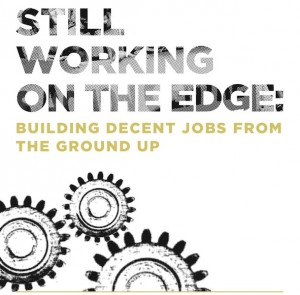My Thoughts on the Launch of the “Still Working on the Edge: Rebuilding Decent Work from the Ground Up” Report on Precarious Labour in Ontario

On 31 March 2015, I had the opportunity to attend the launch of Ontario’s foremost report on precarious labour. “Still Working on the Edge: Rebuilding Decent Work from the Ground Up,” is the follow-up to a landmark report drafted in 2007 by labour rights group the Workers Action Centre and community legal worker Mary Gellatly. The 2007 report, titled “Working on the Edge,” was the first comprehensive look at precarious labour in the province. Since its launch, a recession, an increasing income gap, and a substantial decrease in the full time jobs market, the situation for workers has only worsened.
The launch of “Still Working on the Edge” represents a new opportunity for the Workers Action Centre, Mary, and an inspiring team of volunteers, workers, and activists, to bring the problem of precarious labour to the forefront. In a worsening labour market, the report provides a key pillar upon which to build reforms and mechanisms to protect workers. At the launch of the report, I had the opportunity to hear some of their stories first-hand.
The event was by every measure a success, especially for a topic that may not draw the same initial attention as other, more fashionable causes. With newspaper coverage and a slew of attendees from legal and political backgrounds, the event provided an opportunity to learn more about the problems facing workers in precarious positions. There were a range of speakers, including workers detailing their personal experiences, contributors to the report, and industry and legal experts. The conference also included mediated discussions at our tables, which gave all the attendees an interesting chance to share and learn from a wide range of perspectives and opinions.
Of the speakers, I was particularly impressed with the presentation by Cathy Ruckelshaus, general counsel and program director for the National Employment Law Project in the United States. Cathy went to the effort of not only discussing the well-known issues facing workers in precarious positions, but also highlighted some tangible potential ways to address the problems. I found the review of state efforts to combat common abuses of workers particularly interesting. Knowing that some states have taken steps such as assigning joint and several liability to employers in temp hiring models gives hope that similar mechanisms could be established here.
During the discussion periods, our table frequently circled back to the difficulty of addressing such a wide-spread problem as precarious labour. It is common knowledge that the problems are becoming more entrenched as the income gap grows, income stagnates, and more jobs become low-wage or temporary. What is perhaps surprising, is the reach of these problems into what may have traditionally been considered more stable industries. My table-mates spoke about the issues faced by workers in the education and healthcare systems, as well as the ever-decreasing market for full time jobs. Personally, my feeling is that regardless of position or industry, only one thing will motivate employers to change, and that’s liability. As long as the enforcement mechanisms are weak, and employers benefit from violations more than they stand to lose if caught, it’s hard to foresee any substantial change. If employers definitively knew that the punishment for being caught for a labour violation outweighed any potential cost-benefit of that violation, my assumption is they would seriously rethink their risk assessment.
If we allow the labour market to continue in its current direction, it will hold ramifications for our society as a whole. As employees find themselves less respected, more abused and with fewer job entitlements, they will lose the incentive to do their jobs correctly. As more workers become minimum-wage earners, innovation will stagnate as only entrepreneurs who create luxury items will find themselves with a market for their goods. And perhaps most dangerous of all, as the safety net for workers is eroded by loopholes and cutbacks, more members of society will find themselves falling out of wealth into poverty after a sickness, divorce, or other unforeseen life change.
With the situation spiralling downwards, and such substantial risks emerging, the “Still Working on the Edge” report could not have come at a more crucial time. It is a comprehensive, personal, and in-depth look at labour in Ontario, and allows readers to get a clear overview of some of the problems facing workers, and some of the most succinct and well-reasoned recommendations to improve the labour environment.
Attending the launch of the report further affirmed my confidence in the impressive group of individuals fighting to improve the lives of precarious workers. Now that the effort to gather information has yielded such meaningful results, the next step is to channel the data into action. I am confident that the drafters of the report will not rest now that it’s out, but making province-wide change will also require the help and commitment of the public at-large. Hopefully, the “Still Working on the Edge” report will inspire more people to help with the push for increased minimum standards, better enforcement mechanisms, and legislative reform.
If you are interested in reading the report, I strongly encourage you to visit www.workersactioncentre.org, where it’s provided in PDF form.
